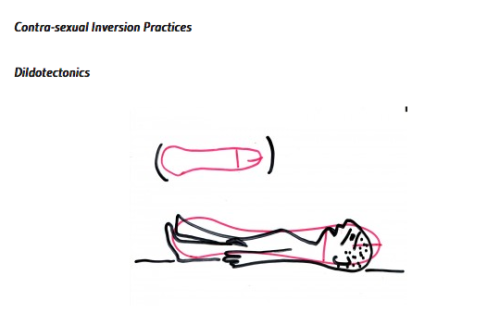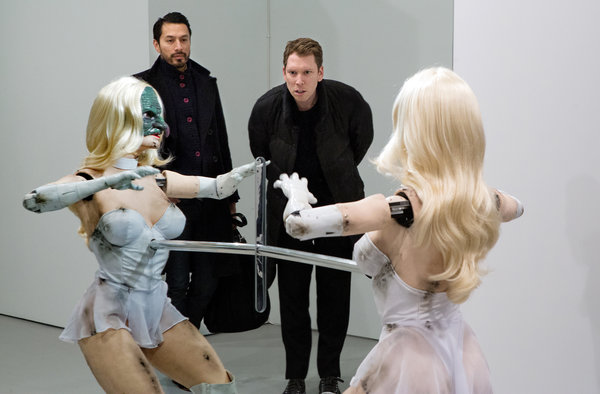Loving machines: A de-anthropocentric view of intimacy
Dorothy Howard

Science fiction and semiotics have co-evolved with STEM in their consideration of the integration of human and machine into hyperreality, a term coined by Jean Baudrillard to mean a simulation of reality indistinguishable from the so-called ’real-thing.’ While scientists might have their own siloed definitions for what is human when examining machinic intelligence, architecture and art, disciplines primarily interested in relationships between things, have also advanced alongside with the question of what it means to be intimate with objects.
Why is the question of loving machines always framed as a question of whether technologies push us towards losing our humanity instead of a question of what new forms of intimacy are we creating? I’d like to make the argument that an acceptance of machinic intimacy requires a multidisciplinary, de-anthropocentric definition of love, utilizing affect theorist Lauren Berlant and Michael Hardt’s speculations on love “as a means of thinking through non-sovereign social and subjective formations.”
A de-anthropocentric view of love might be most immediately associated with queer theory, and even with the proto-queer philosophical theory of Object-oriented ontology (OOO) which takes an object-centered approach, where autonomous objects are considered more than what they are defined by human cognition, perhaps also having desires of their own. This essay seeks to move forward a de-anthropocentric view of love, at the same time recognizing how a sincere queering of intimacy, as represented in the theories of OOO, might be prone to falling into the very traps of exploitation and appropriation which queer theory seeks to avoid.
Planes of Intimacy

The question of whether machines are intelligent is a separate question from whether we can love machines. The growth of consumer products in the internet of things and augmentation technologies– networked but also existing in concrete objects– has made it more difficult to limit definitions of love to the anthropocentric because it’s increasingly hard to define what is human.
Desire beyond humanity was the central theme of Spike Jonze’s Her (2014), a L.A. science fiction romantic comedy which asked us to consider Joaquin Phoenix’s character Theodore’s seduction by his operating system Samantha, played by Scarlett Johansson. The society Jonze imagines conjures up techno-futurist and Director of Engineering at Google, Ray Kurzweil’s zany body of work, which explores automation and machine learning including steps in optical character recognition (OCR). For Kurzweil, the technological singularity, the moment where machine intelligence exceeds human intelligence, is near– but it’s happening gradually, and also by augmentation of the human body, and the addition of the ‘robotic imagination’ into the human psyche, rather than co-evolution of a separate intelligence.
Dramatic tension in the Her hinges on the comparison of Samantha with a hypothetical real human lover. In Kurzweil’s review of the film, he argues that this primary conflict is flawed because, although Samantha doesn’t have a body in the film, such technologies currently exist, including eye-mounted displays that project images onto the wearer’s retinas. For a contemporary example of this method, Stay with Hatsune Miku in AR environment “the virtual girlfriend” an Oculus Rift + Kinect sensor, put together by alsione svx, projects the humanoid persona pop star onto the wearer’s everyday life. While Theodore’s struggle in the film paints the image that machinic love in its most ideal state, would look like, feel like, and sound like, human love, it’s not a given that machines have to exhibit perfect human emotions in order for us to feel intimate with them. In Alex Garland’s film Ex Machina (2015), the hipster mad-scientist Nathan (Oscar Isaac) CEO of the search-engine ’Bluebook’– chooses a young programmer, Caleb to administer the Turing test on his newly built A.I., Ava. While the Turing test is passed if a machine convinces its human evaluator that it is human, and represents one test for machinic intelligence, Caleb starts to fall for Ava before he himself seems sure if Ava has passed the test. While we find that Nathan views Ava’s “liking” for Caleb as a sign of her own cunning and manipulation, this does not negate the attraction felt by Caleb, whose sense of intimacy tempts him to free her from the sterile research quarters where she is monitored.
Martin Heidegger’s work has been instrumental in considering the social shaping of technology. He writes of technology as an instrumentation located in ideas rather than in devices themselves so that the iPad might be thought of as a cluster of technologies being utilized, rather than a technology of itself.
The manufacture and utilization of equipment, tools, and machines, the manufactured and used things themselves, and the needs and ends that they serve, all belong to what technology is. The whole complex of these contrivances is technology. Technology itself is a contrivance, or, in Latin, an instrumentum.
The Question Concerning Technology, and Other Essays (1977)
By this definition, we enjoy technology for its instrumentation, helping us fulfil or express human desires. Perhaps this can be further examined in the ancient relationship between a musician and their instrument. A 2013 article in SourceWire indicated that a common sentiment of the musician separated from the instrument is feelings of “loss” and “devastation,” mentioning also a 2013 study by the University of Finland’s Cognitive Brain Research Unit where “results showed that many musicians express a close relationship with their musical instrument, with those feeling ‘at one’ with and considering the instrument as ‘part of themselves’ experiencing more confidence and less anxiety when performing.”
When my computer caught a virus last year, I felt physically sick myself. Part of this is perhaps related to identity and the intense personalization that is available to us through devices, when the augmentation is made available and becomes a site of personal expression, anything else feels like psycho-somatic deprivation.
Then there is another form of intimacy, that felt between the self and the broken machine. The spiderweb of broken glass of the still-functional cell phone screen is a regular site, the cracks trigger both anxiety and thoughts about the device’s mediation of the world. Wrecked Apple devices in particular can be found at every corner of the internet. The Youtube video “Why would you do this to an awesome iPad” an ‘iPad vs. powertools’ video for example, has over 3 million views and stream of agonized comments that express a mixture of pleasure and pain. There are videos like, “iPad in HOT LAVA.” These videos are the post-jackass response to ’unwrapping’ videos made for packaging lovers, which delicately remove objects from their original boxes and plastics. These videos don’t just enact cultural catharsis at the destruction of one of the most repetitive symbols in modern life, the public horror expressed in these videos makes obvious our cult-like fetishization of their original ’purity/sanctity’ of the phone. This happened with our plastic flip phones, but with the all-glass exterior of the iPhone, things have gotten more intense. From the sleek, Titanium body of the MacBook, to the company’s push to replace keyboards with touchscreens, it’s as if Apple wants to make its devices melt into their surroundings, into the body and made the technical aspects of the device altogether invisible.
The more ubiquitous a medium of communication, the more it tends to disappear in our recognition of the fact that it is a mediating experience at all. Nostalgic or vintage mediums tend to be especially laden, as do recent innovations. This is why sending an email or writing a Facebook message to a friend feels so much less laden with intentionality that has to be managed, than dinosaur technology like sending a fax. But there’s a demand for the most ubiquitous modes of communication to disappear, because disappearance of the medium increases the speed of communication by making it the most common denominator. This is Paul Virilio’s argument in The Aesthetics of Disappearance. Post-internet art was interesting, if nothing else, because it symbolized the idea of human thought merging with the machine and disappearing, taking the machine for granted, perhaps as “nature,” an idea which has pervasively existed as a conversation on the horizon of technological innovation.
The Radical Politics of Loving Machines

In “No One is Sovereign in Love: A Conversation between Lauren Berlant and Michael Hardt,” conducted by Heather Davis and Paige Sarlin in 2011, the two describe the potential for the language of love/ intimacy to be used to represent political strategies which represent a radical acceptance of the unknown. Love as an act of fantasy, imagination, an acceptance of the un-sovereignty, incoherence, and multiplicity of life.
Berlant: The thing I like about love as a concept for the possibility of the social, is that love always means non-sovereignty. Love is always about violating your own attachment to your intentionality, without being anti-intentional. I like that love is greedy. You want incommensurate things and you want them now. And the now part is important.
When you plan social change, you have to imagine the world that you could promise, the world that could be seductive, the world you could induce people to want to leap into. But leaps are awkward, they’re not actually that beautiful. When you land you’re probably going to fall, or hurt your ankle or hit someone. When you’re asking for social change, you want to be able to say there will be some kind of cushion when we take the leap. What love does as a seduction for this is, and has done historically for political theory, is to try to imagine some continuity in the affective level. One that isn’t experienced at the historical, social or everyday level, but that still provides a kind of referential anchor, affectively and as a political project.
Does sleeping with your laptop make you feel less alone? If your answer is yes, what is the best field to help define this experience? The feminist rallying cry ‘the personal as political’ allows the possibility of an interpretation of intimacy as an act of radical sovereignty. Yet there are many types of intimacy; physical, intellectual, political, sexual, familial. Intimacy can be scientific, psychological, literary depending on your frame of reference, but a simple definition might be “relations which lead to a closeness felt and expressed by an ease of relations, a sense of confidence among subjects, an understanding.” The interdisciplinary field of disability studies is one place where conversations about intimacy have flourished. In a May 2011 blog post, scholar Mia Mingus explored the idea of access intimacy, when someone ‘gets’ your access needs, and your needs are met, you are able to relax and open up. She writes of access provisioning as a powerful framework for understanding relationships outside of political intimacy, sexual attraction, and romantic desire, where emergent technologies to improve our access needs can be applied to new forms of intimacy. One example might be translation software for languages we don’t know, and other, process documentation as an intimacy formed between the producer of forms, and the consumer who wants to replicate a process.
Additionally, anthropocentrism is binary and ableist in that it allows the discrimination against trans, otherkin, multiples, schizo, augmented bodies for being “less human.” Such thinking has come out of the Christian concept of the great chain of being, a hierarchy of which classifies the closeness of things / species with god, thus allowing for hierarchy-based oppression to occur. What would it mean to get away from a bodily / genital-based definition of intimacy completely?

Theorist Paul B. Preciado’s “Contrasexual Manifesto” posits new forms of sex considerations after we accept that gender has become a tool of capitalism: a sort of de-centering sex away from the genitals, de-centering love away from the brain / heart “consciousness,” in recognition of the way that sex is a product of the state management of reproduction and sexuality– where condoms, Viagra and performance medicine, birth control, and testosterone– are politically charged in their manifestation of ideology at the molecular level. Dildotectonics then, is a performance-based practice labeled as resistance:
Dildotectonics is the experimental contra-science dedicated to the study of the birth, formation and uses of the dildo. Here the term dildo designates all kinds of technologies of gender and sex that resist the normative production of the body and its pleasures. Dildotectonics’ aim is to draw a general cartography of the cracks and slippages inflicted by the dildo on the hegemonic sex-gender system. To make dildotectonics a critical branch of contra-sexuality is to consider the body as a dildoscape: a living surface where dildos are inscribed and displaced… Dildotectonics locates gender and sexual technologies of resistance. It studies their functioning, the ways in which they interrupt the flow of production of body-pleasure-capital not only within heterosexual but also within queer cultures.
Dildotectonics points to ways of using the body that resist the sanctioned ways we are told pleasure can be found, and is as such useful as a term for validating new forms of intimacy / pleasure we feel towards machines. Circling back to Berlant and Hardt’s reflections on love as the radical acceptance of the unknown, an act of fantasy, imagination, an acceptance of the un-sovereignty, incoherence of life, perhaps we can gesture towards these expanded definitions and appreciations for machinic love, while also being critical of their flaws.
The Colonialism of Openness in Object Oriented Ontology

“Greater transgender visibility hasn’t helped nonbinary people like me” read a headline by writer Alok Vaid-Menon in The Guardian.
Prof. Jordana Rosenburg’s essay, “The Molecularization of Sexuality,” a critique of the self-called ‘movement’ of Object-oriented ontology brought to my attention in Alexander Galloway’s October 21, 2014 blog post Queer Atonality address the recent trend towards what she calls molecular ontologies, or philosophical queerings, found in Object-oriented ontology, speculative realism, new materialism, and post-internet art. Rosenburg addresses these various theoretical approaches, how ’onto-primitivism,’ seen in anti-Kantian Graham Harman’s “speculative realism,” Timothy Morton’s Hyperobjects: Philosophy and Ecology after the End of the World (2013), and paper, "Queer Ecology," as well as the writings of Ian Bogost, and Bruno Latour, push for an all-embracing philosophical openness with a greedy appetite over cultural forms. Such theories might wish to spark conversations about globalization and global warming through an acceptance of material realities, yet they insulate themselves among a concentrated group of elite, Western, academic institutions and white-male gaming communities copying the frameworks of feminism and queer studies without giving credit.
Rosenburg’s essay questions the dangers of appropriation– where the popularization of gender fluidity contributes to a loss of context for the subject that most deeply identifies as queer. Her critique asks us to consider how identity acceptance under capitalism can be read as the opening up new market possibilities for capitalism and commodities, rather than a sort of emancipation from gender categories, as if gender fluidity specifically appeals to capitalism.
In technology queering objects is synonymous with "openness," open sourcing, where globalization has pushed the opening up of previously ’copyrighted’ or culturally protected categories of spurring creativity and competition while increasing potential points of contact. While there are undeniable advantages to open-sourcing, and the the wider acceptance of non-binary approaches alike, the dangers of appropriation via globalization include the loss of meaning to those who most deeply identify with certain types of ideas, content, and expression.
The Breakdown of Machine Intimacy: The Trope of the Sexbot

Rosenburg’s line of critique against “molecular ontologies” like OOO shows how theories which seek to de-anthropocentrize might fall victim to seizing concepts as property/ eminent domain without giving them the agency and privacy they deserve. In this line of critique, many who have noticed how the question of how far we can advance machines tends to become also a question of how realistic we can make pornography. Documentarian Allison de Fren’s has depicted the subcultures surrounding the production of sexbots in the films The Mechanical Bride, and the film, a.s.f.r.(alt sex fetish robots; 2001). “Advertising’s ideal woman is a fragmented body of replaceable parts, whose origin is the assembly-line logic of consumer capitalism...the RealDoll is the culmination of that kind of logic. It’s ordered in the exact same way as a car, with detailed customization including head and body type, hair and eye color, breast size and lips,” she said in a Wired interview. This concern is part of a strain of theory that worries that love felt towards technology is a result of an acceptance of the alienation of machines on identity– using Jean-François Lyotard’s notion of The Libidinal Economy, based around Sigmund Freud’s theory of the libido, points to libidinal energy– psychic motivations leading us towards sex– as the driving factor for societal transformations, similar to Deleuze and Guttari’s notion of the mechanization of the production of the social as a process of extracting human desire and replacing it with commodified objects.
Answering a question about the ’Golden Era of Sci-fi’, where women were often invisible from award-winning books, science fiction writer Ursula K. Le Guin noted in a 2014 interview that these days, "there are so many female leads you can’t count them (yet) some of them have female names and tend to act like men. You know the kickass hero woman, I’m getting a little tired of her" she remarked. While many of Le Guin ’s fantastical characters are gender-fluid and psychologically dense, the science fiction femme fatale female has a long history of emotional flatness.
Contemporary artist Jordan Wolfson’s installation, Female Figure (2014), an animatronic gynoid constructed in collaboration with the L.A. special effects studio Spectral Motion depicts the robot as a site of male sexual fantasy. The trope of the technofetishistic cyborgian sexbot ascribes pornographic submissiveness, passivity, and docility to what’s labeled as the female form, but the gaze, concentrated in the eyes, remains a crucial way that is used to define the believability of a robot. Wolfson exploited the realism of the animatronic figure to the point of a sort of conceptual nightmare for art with the figure literally appearing to be ’looking into the eyes’ of the viewer using facial recognition technology: the theoretical gaze of art objects ‘looking back,’ anthropomorphized to trigger the horror and hesitation in the moment of realizing machine intelligence.
An anthropocentric instinct to protect humanity in the competition with other species might be responsible for another form of resistance to cyborgs– the worry that they might one-day replace humanity’s traditional work and affective roles, without new ones being created for us to fill. Female competition with robotic forms, and subsequent feelings of inadequacy, come up in the manga comic, Chobits (ちょびっツ Chobittsu) by the artist group CLAMP. Hideki Motosuwa the comic’s lovable loser protagonist, finds a Personcom, with a wiped memory, which he names Chi. The story continues as a sort of rescue narrative where Hideki expresses waves of embarrassment at the sort of sexual implications of owning a Persocom, and then late confidence as he begins to show signs of affection for Chi; buying her underwear coyly, for example. In the comic, Hideki’s other love interest, Yumi expresses anxiety about her inferiority to female Persocoms. Jealousy comes to a peak at the moment of encountering a robot that is able to labor to perform the heedless socially conditioned womanhood better than the human.
Tropes of sexbot have also included questions about what happens when machines go awry, when the bionic woman becomes over-sexed, then comes the persistent metaphor of unleashing the evil’s of Pandora box’s or the male equivalent– Frankenstein’s grotesque consciousness. The Pandora myth as applied to technologies manifests in the fear that female robots will, like their human counterparts, fall victim to hysteria, or engage in castration anxiety-inducing behavior. Freudian women, victim to overwound maternal instincts and squishy thinking, of the type depicted to their violent extremes in Lars Von Trier’s Dogme 95 realist movies Dogville, Antichrist, Nymphomaniac, and his use of “cruelty perpetrated on-screen to terrorize (the) audience” in what Moira Weigel has termed sadomodernism. As Laura Mulvey notes in Fetishism and Curiosity (1996) “Pandora is the first in a long history of femme-fatale androids—creatures in which "a beautiful surface that is appealing and charming to man masks either an ’interiorl’ that is mechanical or an outside that is ’deceitful’; this ’inside/outside topography’ connotes ’mysteryl’ and is ’only readable in death’." Explorations about alienation and the sexbot are bolstered by research on the effect of how the access to and participation in the creation of new technologies often creates blind spots in these technologies.
Radicalizing love
Moving forward a de-anthropocentric definition of machinic love will require an examination of the the pitfalls of technological factors of alienation on identity, including the tendency of loosely applied queer theory being misused to justify globalization rather than a realized route to identity acceptance. Such a task cannot be accomplish in this paper, but might best be done by continuing to explore definitions of love based on a collaboration amongst scientists, psychologists, gender theorists, and art historians.*~
back to the top ⤴︎